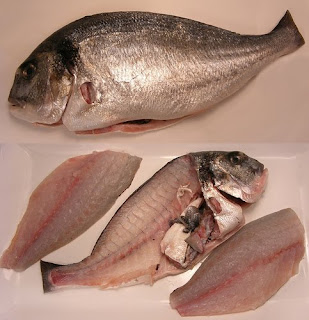Fish Yields - or - How Much Does This Really Cost Me?

- Salmon (head-on gutted) yields 75% skin-on fillet
- Snapper (head-on gutted) yields 40% skin-on fillet
- Mahi (headed and gutted) yields 65% skin-on fillet
- Monkfish (tail) yields 70% skinless fillet
- Cod (headed and gutted) yields 60% skin-on fillet
- Grouper (head-on gutted) yields 35% skinless fillet
- Halibut (headed and gutted) yields 66% skin-on fillet
- Tuna (headless bullets) yields 75% untrimmed loins
- Sword (headless bullets) yields 80% center cut
- Fluke and Flounder (whole fish) yields 35% skinless fillet
- Skate (wings) yields 35% skinless fillet
- Wild Striped Bass (whole fish) yields 33% skin-on fillet
Example: To find out how much whole salmon you need to get ten pounds of fillet you would convert the yield percentage to hundredths (75% = .75) and then divide 10 by that number. So 10/.75= 13.33, so you would need about 14 pounds of whole salmon to give you 10 pounds of fillet.
If you paid $7.00 a pound for whole salmon then to figure out your fillet cost you would then divide the whole price by the yield percentage $7.00/.75= $9.33
To determine how much fillet you get from whole fish simply convert the percentage to hundredths and multiply. Lets say you have a 20 pound wild striped bass, your fillet yield would be 20 x .33 = 6.6 If you paid $5.00 a pound for the fish your fillet cost would be $7.00/.33 or $21 per pound.
So plan accordingly and take into account fish yields when making your purchasing decisions. It is easy to see that whole fish prices can be misleading if you do not have an accurate concept of fillet yields.

Comments